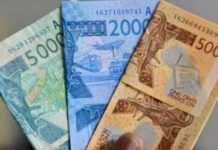GNPC – Summary findings and recommendations
2.106 The Financial Statements detail that GNPC has been profitable in six of seven years covering 2010 to 2016. In 2015 it posted a loss due to increased administrative costs for overseas travels and increased bank charges realized in the year. GNPC is technically solvent based on the figures in the Financial Statements and the draft Management Accounts provided.
2.107 The External auditors issued a qualified opinion for the 2015 Financial Statements, as well as
a “Disclaimer of Opinion” on the 2016 Financial Statements. The “Report of the Independent Auditors” in the Financial Statements for both years raised issues which could impact the profit for 2017.
AD
Table 16: Summary Balance Sheet as at December 31, 2017
2016
(GMD’000)
2016 (USD’000)% of asset
/ liability total
2017 (GMD’000)2017 (USD’000)% of asset
/ liability total
Non-Current AssetsFixed Assets 379,704 8,67613%429,0118,93617%Equity Investments 128,210 2,9304%157,2953,2766%Current AssetsCash 185,186 4,2326%61,9581,2913%Trade and Other Receivables 2,043,17846,68767%1,804,60737,59073%Staff Loans12,5562871%17,8403721%Inventory 284,148 6,4939%000%LiabilitiesTrade Payables 1,722,152 39,35187%1,515,51131,56894%Other Payables 185,828 4,2469%88,6921,8476%Corporation Tax 83,867 1,9164%–––Net Assets / Equity 1,041,135 23,790866,50818,049
Source: EY analysis of GNPC 2016 Financial Statements and 2017 draft Management Accounts. We applied exchange rates of GMD 43.764: USD 1 for 2016 and GMD 48.008: USD 1 for 2017. Therefore, the GMD depreciated by almost 10% between the two dates.
2.108 Additionally, our review of the 2017 draft Management Accounts indicates that the technical solvency of the company is dependent upon the collectability of a large Trade Receivable from The National Water and Electricity Company (“NAWEC”). This is the largest single asset
on the Balance Sheet of GNPC. Management estimates the debt at GMD 833m
(USD 17.35m). Given the financial difficulties at NAWEC, it is highly unlikely that GNPC will be able to recover this debt.
2.109 The December 2017 draft Management Accountsof GNPC currently presents a Retained Earnings balanceof GMD 847m (USD 17.6m). If the entirety of the NAWEC receivable is written-off or provided for, this alone would reduce the Retained Earnings balance to GMD 13.5m (USD 281k).
2.110 We note that the draft Management Accounts of GNPC may require several additional writeoffs which could quickly cause the Retained Earnings balance to become negative. For example, if GNPC writes-off all the GNPC station receivables from the Trade Receivables sub-ledger, this alone would constitute a write-off of GMD 131.9m (USD 2.7m).
2.111 Senior Management and the Finance team at GNPC were very receptive and helpful throughout the course of the fieldwork. However, the Finance team faced difficulties in providing documentation and functional reports due to both incomplete physical records, as well as an accounting system (Navision) which is not fully equipped to handle the reporting requirements for the entity.
2.112 We note that GNPC currently has difficulty in providing complete and verifiable documentation from both a technical and physical perspective. GNPC’s Navision accounting system, which maintains GNPC’s financial reporting information, suffered a failed migration in 2017 which caused several financial reporting issues. The Finance team at GNPC has also noted that the system is unable to generate several key reports expected in any accounting system.
2.113 GNPC was unable to provide supporting documentation for several samples that we selected. Generally speaking, the unavailable documentation related to activities which took place in the period under the previous regime. We note that the inability to produce supporting documentation will cause difficulties for GNPC as it will be unable to substantiate balances for the 2017 Statutory Audit.
2.114 Based on our findings during the Forensic Audit, it appears that any Financial Statements that Management provide for the period ended December 31, 2017, could not currently be satisfactorily subject to External Audit. This is consistent with the ‘no opinion’ audit opinion reported by the external auditors for the 2016 Financial Statements.
2.115 The Finance team were very open about any issues encountered and acknowledged many of the findings as areas they aim to remedy in the oncoming months. This includes using the new accounting platform (FinEx) to address the Revenue, Inventory, and Cost of Sales recognition issues discussed below. We understand that the migration to the new platform is currently underway.
Financial impact of the issues identified
2.116 The approximate financial impact of the issues highlighted in our work to date are captured in
the tables below, shown against the net equity position of the draft Management Accounts as at December 31, 2017. Issues that cannot be or have not yet been quantified are explained more fully in the commentary:
Table 17: Financial impact of issues uncovered during the Forensic Audit
2017 2017
Brief description of issue (GMD’000) (USD’000)
Net Assets / Equity as at December 31, 2017866,50818,049Section 1 – Adjustments that could be quantified (above USD 20k)1. Impairment of NAWEC receivable(832,977)(17,351)2. Write-off of station receivables(131,906)(2,748)
Section 2 – Adjustments that could not be quantified, however could be broadly estimated:
Section 3 – Adjustments that cannot currently be quantified nor estimated, but likely to be above USD 20k:
3. Reconciliation of Trade Receivables balancesTBDTBD4. Accounting adjustments for Upstream fundsTBDTBD5. Inventory recognition and valuation for the yearTBDTBD6. Reconciliation of Trade Payables balancesTBDTBD7. Reconciliation of Cash and Cash Equivalent balancesTBDTBD8. Adjustment of Fixed Assets balancefollowing full asset verificationTBDTBD9. Depreciation adjustmentTBDTBD10. Fuel cost of sales recognition for the yearTBDTBD11. HFO accounting lossTBDTBDSuggested revised Net Liabilities / Equity following adjustments in Section 1 and Section 2 only(98,375)(2,050)
2.117 We note that the nature of the findings above and the incomplete status of the accounts removes our ability to make multiple recommended adjustments to the accounts. Many of the balances have changed significantly in the period between us receiving the 2017 draft Management Accounts and the issue of subsequent Trial Balances. Accordingly, we have highlighted several of the key potential findings which threaten the financial position of the business.
2.118 From the summary of findings, it is evident that the accounting policies and procedures at GNPC are deficient (as regards the absence or non-application of accounting policies, absence of essential accounting procedures and absence of supporting documentation for accounting entries) and consequently little or no reliance can be placed on the 2017 draft Management Accounts. Moreover, Senior Management does not have the relevant, accurate, up-to-date financial information to manage the business effectively.
2.119 We recommend that consideration is given to GNPC not being subject to an External Audit for the next two years while Senior Management rectify these serious flaws and become able to produce Financial Statements that are of auditable quality. We make this recommendation because External Audit is a time-consuming activity which helps neither Senior Management or the reader of the Financial Statements in the present circumstances.
Significant findings
2.120 Our significant findings in relation to our Special Audit of GNPC as at December 31, 2017, which are explained more fully in this section of the report, are as follows:
Reconstruction of the GNPC Balance Sheet (Financial impact table item 3)
► For a period lasting approximately one year (August 2016 to August 2017) there was no effective finance leadership at GNPC. At one point, there was no Finance Director. For the remainder of the period, interviews with the Finance team and Senior Management indicate that the acting Finance Director did not have the appropriate technical and management capabilities or qualifications to run the finance function. This led to a significant backlog of key financial reporting controls and procedures, and a lack of direction which led to a prevalence of incorrect accounting practices.
► This breakdown of governance and key financial controls has greatly hindered the accuracy, existence, auditability, timeliness and transparency of the financial records at GNPC.
► In 2017, a new Finance Director was brought to GNPC to address the financial reporting concerns at the entity. The Finance Director hired additional qualified resources to address the fundamental gaps in the financial records. The Finance team has since begun a major financial reconstruction exercise to clear the large backlog of financial reporting controls and reconstruct the key areas of the Balance Sheet in order to restore integrity to the Financial Statements. He has assembled three teams focused on fully reconciling the balances for Cash, Trade Receivables and Trade Payables. Given the severity of the historical problems, this exercise is proving time consuming and complex.
► We recommend that GNPC continue to financially reconstruct the 2017 accounts and clear the backlog of key financial controls. We recommend they continue to focus on Cash, Trade Receivables, Trade Payables, an Inventory as priority areas.
► We additionally recommend that GNPC recruit or contract additional skilled resources to aid in this process as the backlog of controls and procedures is significant.
Recoverability of NAWEC Trade Receivable (GMD 833m, USD 17.35m / 34% of Total
Assets) (Financial impact table item 1)
► The NAWEC receivable is the largest single asset on the Balance Sheet of GNPC. Management estimates the debt at GMD 833m (USD 17.35m). Given the financial difficulties at NAWEC, it is highly likely that GNPC will not be able to recover this debt. In our review of the centralized plans to resolve NAWEC’s financial obligations, we saw no mention of a formal plan to settle their trade payables liability to GNPC.
► Trade Receivables also includes the amount of a GMD 585m (USD 12.2m). Management has not been able to provide support for this amount, which is Management’s estimate of the foreign exchange (“FX”) gain on foreign currency receivables (most notably NAWEC). The NAWEC receivable is so significant that should GNPC be unable to recover any payment at all, GNPC could become close to technical insolvency.
► We recommend that GNPC, NAWEC and the Government of The Gambia meet to agree a formalized plan of action in respect to NAWEC’s debt to GNPC.
Inconsistent accounting treatment applied to Upstream funds (GMD 225m, USD 4.9m for the year ended December 31, 2017) (Financial impact table item 4)
► Funds collected from upstream activities have been inconsistently accounted for over the period from 2010 to 2017 and no formalized accounting policy or agreement for the accounting treatment exists. We recognize the uncertainty faced by GNPC Senior Management in establishing the correct accounting treatment given the legal and commercial implications for the parties involved in generating the upstream funds.
► We recommend that GNPC, the Ministry of Petroleum and Energy (“MoPE”) and the Government of The Gambia review the mechanism in which GNPC and MoPE account for upstream funds. We also recommend that any policy or agreed upon accounting treatment is implemented as soon as possible into the financial accounts. This should include a review of how to account for the different aspects of the licensing fees on an accruals basis.
Petrol stations treated as customers (GMD 131.9m, USD 2.7m / 5% of Total Assets)
(Financial impact table item 2)
► Fuel movements from the Gam Petroleum depot to the nine GNPC stations are incorrectly treated as sales to customers, and the resulting balances with the stations are incorrectly recognized as receivable balances. Multiple conditions for revenue recognition under International Accounting Standard 18 (the relevant revenue accounting standard as at December 31, 2017) are not satisfied. We noted the following:
▶ GNPC had not transferred to a third-party buyer the significant risks and rewards of ownership of the goods;
▶ GNPC retained both continuing managerial involvement to the degree usually associated with ownership and effective control over the goods sold; and
▶ It was not yet probable that the economic benefits associated with the transaction would flow to GNPC.
► As at December 31, 2017 Trade Receivables from GNPC stations are valued at GMD 131.9m (USD 2.7m). The correct accounting treatment is to treat fuel at the depot and the nine stations at cost (or net realizable value in the unlikely event this falls below cost) until sold to a third party. The overall impact on the Balance Sheet of this improper accounting treatment is that assets and revenue are overstated at the end of the financial period.
► We recommend that all the petrol station receivables should be written out of Trade Receivables. Inventory should then be recognized at the lower of cost and net realizable value. Going forward transfers between the depot and the stations should be treated as Inventory movements.
No Inventory balance in draft Management Accounts (Financial impact table item 5)
► Current practices to account for Inventory do not adequately track or manage the Inventory balance throughout the financial period. Accordingly, Management was unable to calculate an Inventory figure for the draft Management Accounts.
► We recommend GNPC revises the accounting procedures for the purchase, receipt and issues of fuel in line with the good industry practices. This includes recognition of the assets in the Inventory account, and a corresponding liability in Trade Payables upon the receipt of the fuel and its related invoice. For the fuel that has been receipted but not yet invoiced, we recommend that GNPC establish a process to account for it in a Goods Received and Not Invoiced (GRNI) General Ledger (GL) account.
► A 100% inventory account needs to be performed in accordance with good practice to establish an opening position for inventory and a physical inventory tracking system developed. Thereafter, periodic test counts need to be performed to check the ongoing accuracy of the accounting records.
Trade Payables balance unsupported (GMD 1.5b, USD 31.6m / 94% of Total Liabilities)
(Financial impact table item 6)
► Trade Payables contains a manually calculated estimate separate from the accounting system. We note GMD 709m (USD 14.8m) was manually added to the Trial Balance figure by the Finance team to bring the balance in line with current estimates of the balance. Additionally, the Trade Payables sub-ledger does not accurately reflect supplier balances due to an incorrect accounting treatment for supplier payments and fuel purchases.
► The Islamic Trade Finance Corporation (“ITFC”) loan facility requires a full reconciliation between the Government of The Gambia, GNPC and ITFC. The final financial liability and its associated beneficiary will not be clear until this is concluded.
► We recommend that GNPC performs a full supplier-by-supplier rebuild of the Trade Payables sub-ledger, including the ITFC liability. This will allow GNPC to identify their actual liability to all suppliers as of December 31, 2017. It will also allow GNPC to better manage their working capital and resolve any potential supplier disputes.
We also recommend that GNPC immediately ceases the practice of directly debiting any cash payments into the Trade Payables sub-ledger when they are not associated to a specific invoice which has been entered into the ledger. This will prevent the build-up of debit balances in the ledger and assist in maintaining a more accurate view on the Trade Payables balance.
Ongoing Cash and Bank reconciliation (GMD 61.96m, USD 1.29m / 3% of Total Assets)
(Financial impact table item 7)
► The 2017 cash position cannot be currently determined as bank reconciliation and consolidation procedures are still ongoing. The value on the face of the Balance Sheet was calculated based on an incomplete selection of cash GL accounts and a manually added adjustment.
► The bank accounts confirmed by GNPC and the bank accounts present in the accounting system require review and reconciliation.
► We recommend that GNPC continue the bank reconciliation procedures and investigates all discrepancies between the cashbooks in Navision and the current listing of bank accounts.
Retained Earnings used as balancing figure (GMD 846.5m, USD 17.6m)
► Retained Earnings is currently a balancing figure in the draft Management Accounts. This means the value of the figure has been manually calculated and inserted in order to equate GNPC’s Net Assets to the Total Equity (with no basis) on the Balance Sheet.
► We recommend that GNPC continues the current financial reconstruction efforts in order to reach an accurate Retained Earnings figure which would be representative of the 2017 financial period.
Diversion of funds
► The Office of the President has historically accessed the upstream funds collected by GNPC in the USD bank accounts. This resulted in the GMD 251.7m (USD 5.7m) write-off of Government debt and could account for further cash diversions.
► GNPC has been the target of several Executive Directives for loans and political donations which have not brought any recognizable benefit to the business. These loans and donations are valued at, as a minimum, GMD 38.3m (USD 1.4m).
► We recommend an independent investigation of the GNPC USD accounts is conducted to better quantify the diversions of GNPC funds during the time of the former regime.
► We recommend that GNPC create a formalized policy and associated governance process in respect to all sponsorships and donations to reduce the risk of diverted funds disguised as charitable donations or sponsorships.
Land purchase
► Our review of Board minutes highlighted discussion between the Board and Management regarding a significant land acquisition, the purchase contract for which was signed in December 2017. The Board minutes capture a concern raised by a Board member that the land was purchased at a significant overvalue. Our enquiries to assess the governance around the acquisition included discussion with the current Minister of Finance, who was the GNPC Managing Director at the time of the purchase.
The Minister of Finance explained to EY that while the purchase price was high at GMD 17m (USD 310k), his team negotiated a discount from the GMD 19m initial valuation, which was commissioned by the seller, and represented excellent value considering the strategic importance of the site.
► Central to our audit enquiries was a valuation report that was produced by a Gambian valuation company, Sphinx Associates Gambia Co. Ltd in, October 2017. We have reviewed the report and confirmed that it independently valued the land and buildings at GMD 19m.
Potential discrepancies in Fixed Assets (GMD 429m, USD 8.9m / 17% of Total Assets)
(Financial impact table item 8)
► The Fixed Asset balance per the Management Accounts and the Fixed Asset Register potentially contain assets which do not exist or have no residual value. A full asset verification exercise is required to establish an accurate position.
► We recommend that GNPC engages a third party to perform a full Fixed Asset verification and valuation to properly revalue their asset base.
Other findings
2.121 Other findings in relation to our Special Audit of GNPC as at December 31, 2017, which are explained more fully in this section of the report, are as follows:
Trade and Other Receivables (GMD 1.8b, USD 37.6m / 73% of Total Assets)
► GNPC has several potentially uncollectable Trade Receivable balances. This includes a balance from the Office of the President and GAMTEL, which are estimated at GMD 81.1m (USD 1.7m).
► We recommend that a robust bad and doubtful debt provisioning policy is designed






